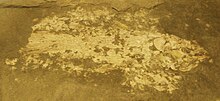Ticinepomis
Appearance
| Ticinepomis Temporal range: Lower Ladinian,
| |
|---|---|

| |
| Fossil | |

| |
| Reconstruction | |
| Scientific classification | |
| Domain: | Eukaryota |
| Kingdom: | Animalia |
| Phylum: | Chordata |
| Clade: | Sarcopterygii |
| Class: | Actinistia |
| Order: | Coelacanthiformes |
| Family: | Latimeriidae |
| Genus: | †Ticinepomis Rieppel, 1980 |
| Type species | |
| Ticinepomis peyeri Rieppel, 1980
| |

Ticinepomis is an extinct genus of coelacanth lobe-finned fish which lived during the Middle Triassic period in what is now Canton Ticino, Monte San Giorgio, Switzerland. It contains a single species, T. peyeri. It was originally described as being a member of the family Coelacanthidae, being similar to Coelacanthus, Holophagus and Undina.[2] Later, T. peyeri was placed in Latimeriidae.[3] The recently discovered bizarre latimeriid Foreyia is thought to be T. peyeri's closest relative, as they share many features despite their drastically contrasting appearances.[4]
References
- ^ Scheyer et al. (2014): Early Triassic Marine Biotic Recovery: The Predators' Perspective. PLoS ONE https://doi.org/10.1371/journal.pone.0088987
- ^ Rieppel, O. (1980). "A new coelacanth from the Middle Triassic of Monte San Giorgio, Switzerland". Eclogae Geologicae Helvetiae. 73 (3): 921–939.
- ^ Cavin, Lionel; Furrer, H.; Obrist, C. (2013). "New coelacanth material from the Middle Triassic of eastern Switzerland, and comments on the taxic diversity of actinistans". Swiss Journal of Geosciences. 106 (2): 161–177. doi:10.1007/s00015-013-0143-7.
- ^ Cavin, L.; Mennecart, B.; Obrist, C.; Costeur, L.; Furrer, H. (2017). "Heterochronic evolution explains novel body shape in a Triassic coelacanth from Switzerland". Scientific Reports. 7 (1): 13695. doi:10.1038/s41598-017-13796-0. PMC 5651877. PMID 29057913.


